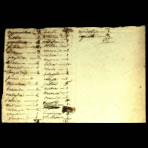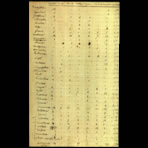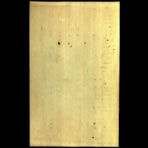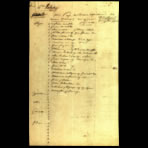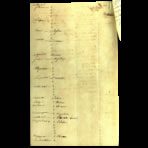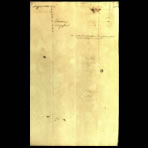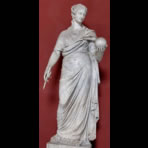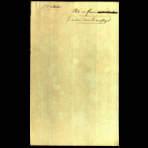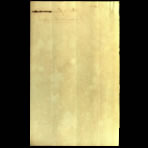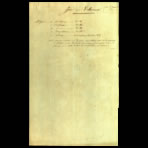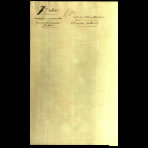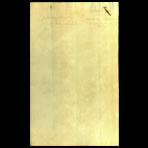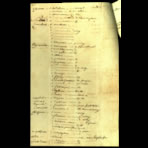Scientific Notes of Gaudichaud Beaupré click on the thumbnail to view full-size image
In this important lot of classifieds and numbered pages of scientific and personal notes of Charles Gaudichaud Beaupré, silent survivors of the shipwreck of L´Uranie, we may observe the annotations in order of every one of the plants that were classified at the same time of their findings in each explored region of this expedition around the world between 1817 to 1820.
Any of these scientific notes was previously published, and for more than one hundred and ninety-four years continue being in their original order, fastened or knotted with boiled wires, or stapled together with needles as such as Gaudichaud leaves it to us.
Any document of this botanical cabinet has been restored, everything kept as Gaudichaud left it the January 16, 1854 when he died, and being the entire lot was carefully preserved for generations by the descendants until today.
These documents talk by their own about the absolute and hard dedication of the scientists of our preceding centuries into the world of the scientific investigation, particularly those of the 19th Century for the benefit of the medicine, arts, entomology, ichthyology, and meteorology and for all the knowledge and future generations to come.
Fernando Wamprechts.
CORVETTE L´URANIE.
• Commander:
Louis Claude de Saulces de Freycinet (1779-1842).
• Second:
Ensign Duperrey Louis Isidore (1786-1865).
• Doctors naturalist´s:
Joseph Paul Gaimard (1796-1858) and Jean René Constant Quoy (1790-1869).
• Botanist:
Charles Gaudichaud-Beaupré (1789-1854).
• Illustrator & artist:
Jacques Arago (1790-1855)
Narrative:
The corvette Uranie left Toulon 17 Sept 1817 with a crew of officers assigned to do zoological observations, i.e., Jean René Quoy (surgeon major) and his assistant Joseph Paul Gaimard; and botanical collections, i.e., the pharmacist Charles Gaudichaud-Beaupré. After plying the Mediterranean Sea for a month, the ship sailed to Tenerife, Rio de Janeiro, the Cape of Good Hope, W. Australia, Timor, the Moluccas, the Carolines, Sandwich Is., So. Australia at Port Jackson and Tierra del Fuego. A first shipment of collections was sent from Mauritius. On 14 Feb 1820, while in the Malvinas, the Uranie suffered serious damage when she struck a reef and the crew had to abandon ship. Numerous collections were lost, including live animals, and the shipwrecked crew stayed in the Malvinas for two months until an American ship, the Mercury, agreed to carry the survivors to Montevideo. Freycinet purchased the Mercury and renamed it the Physicienne and continued his way to Rio de Janeiro and thence to Le Havre where the expedition ended in 13 Nov 1820. Although he had to face court martial on account of the loss of the Uranie, Freycinet was acquitted and promoted to captain. The narrative of his voyage was to occupy him till his death in 1842. Examination of the collections, which were at least as large as those of the Baudin expedition, continued for a long time, interrupted by new missions for Quoy and Gaimard, and the results were not published until 1824. As for the fishes, 164 species were brought back and 137 described; 62 are illustrated in the Atlas, drawn either by Jacques Étienne Victor Arago or by Quoy himself. The infinite patience and determination of Gaudichard-Beaupré in retrieving his herbarium from the shipwrecked Uranie (he washed the plants in freshwater and dried them again) and thus saving two thirds of the shipwrecked botanical collection is here noteworthy of the dedication of voyageur-naturalists of the time (see Bauchot et al. 1990).
Louis de Saulces de Freycinet
In 1817, he commanded the corvette L´ Uranie, in which Louis Isidore Duperrey, Jacques Arago, Charles Gaudichaud Beaupré, Adrien Taunay the Younger and others went to Rio de Janeiro, to take a series of pendulum measurements as well as a larger scheme for obtaining observations, not only in geography and ethnology, but in astronomy, terrestrial magnetism, and meteorology, and for the collection of specimens in natural history. Freycinet also managed to sneak his wife Rose de Freycinet aboard, with a guard of 17 officers.[3]
For three years, Freycinet cruised about, visiting Australia, the Mariana Islands, Hawaiian Islands, and other Pacific islands, South America, and other places, and, notwithstanding the loss of the Uranie on the Falkland Islands during the return voyage, returned to France with fine collections in all departments of natural history, and with voluminous notes and drawings of the countries visited.
The results of this voyage were published under Freycinet's supervision, with the title of Voyage autour du monde sur les corvettes Uranie et la Physicienne en 1824–1844, in 13 quarto volumes and 4 folio volumes of plates and maps.
Freycinet was admitted into the French Academy of Sciences in 1825, and was one of the founders of the Paris Geographical Society. He died at Freycinet, Drôme.
Charles Gaudichaud-Beaupré.
(September 4, 1789 – January 16, 1854) was a French botanist.
He was born in Angoulême, the son of J-J. Gaudichaud and Rose (Mallat) Gaudichaud. He studied pharmacology at Cognac and Angoulême. He also studied chemistry and herbology.
His greatest claim to fame was serving as botanist on a circumglobal expedition from 1817 to 1820. He accompanied Freycinet, who made the expedition on the ships Uranie and Physicienne. He is known for his collections in Australia.
In 1831 Gaudichaud sailed on L'Herminie to South America, visiting Chile, Brazil and Peru. In 1836 he undertook a third voyage, circumnavigating the globe on La Bonite.
ITINERARY OF THE TRAVEL AROUND THE WORLD AT THE CORVETTES L´ URANIE, LA PHYSICIENNE, 1817-1820.
17-September-1817.
Departure from Toulon, France.
29-September-1817.
In view, Gibraltar, but the winds are contrary and push the ship to the Mediterranean.
11-Oct-1817 finally landing in Gibraltar.
14-Oct-1817.
Leaving Gibraltar.
22-Oct-1817.
Arrival at Tenerife.
28-Oct-1817.
Departure from Tenerife.
6-Dec-1817.
Arrival at Rio de Janeiro.
30-Jan-1818.
Departure from Rio de Janeiro.
7-Feb-1818.
Arrival at Cape Town.
7-April-1818.
Departure from Cape Town.
5-May-1818.
Arrival at Ille de France.
16-Jul-1818.
Departure from IIle de France.
19-Jul-1818.
Arrival at Saint-Denis, IIle Bourbon (Reunion).
28-Jul-1818.
Final departure from Saint-Paul, IIle Bourbon.
11-September-1818.
In view of New Holland (Australia), north side of the Earth of Edels.
12-September-1818.
Stop at the mouth of the Bay Chiens Marins, (Shark Bay, Australia) New Holland, north of the island of Dirck Hartog.
13-Sep-1818.
Landing at the Dampier Bay, at the Point of the Peninsula Peron.
26-September-1818.
Departure from Shark Bay.
9-October -1818.
Arrival at Kupang (Coupang, Timor, Indonesian side) Dutch West Indies.
23-Oct-1818.
Departure from Kupang or Coupang.
17-Nov-1818.
Arrival at Diely (Dili) East Timor.
22-Nov-1818.
Departure from Diely.
16-Dec-1818.
Arrival at Rawak (Pulau Lawak, northern Waigeo, West New Guinea, Indonesia) - Via Amboina, Strait Manipa, Halmahera Sea, Strait of Jailolo and Strait of L´Uranie.
6-Jan-1819.
Departure Rawak, the Ecuator is on the road.
25-Feb-1819.
Continuing for 12 days at the islands of the Admiralty, before changing the course towards the Carolinas.
17-Mar-1819.
Arrival at Umatac, island of Guam.
4-Apr-1819.
Transfer from Umatac to St. Louis and in the evening to Agana.
4-Jun-1819.
Boarding crew in St. Louis, and June 6 Finally departure to the Sandwich Islands (Hawaii).
5-Aug-1819.
In view, the Sandwich Islands, Owyhee Island (Hawaii).
8-Aug-1819.
Stop at the Bay Kayakakoua (Kealakekua, Hawaii).
12-Aug-1819.
Stop at the Bay Kohai-hai (Kowaihae, NW of Hawaii).
16-Aug-1819.
Stop at the Isle of Mowi (Maui).
26-Aug-1819.
Stop at the Isle of Woahou (Oahu).
30-Aug-1819.
Final departure of the Sandwich Islands.
21-Oct-1819.
Discovery of the Rose Island.
18-Nov-1819.
Arrival at 20.00 antemeridian at the Bay of Port Jackson (Sydney).
25-Dec-1819.
Departure of Port Jackson at 20.00 pm.
7-Feb-1820.
Vía Cape Deseado (Cabo Pilar).
8-Feb-1820.
At the Cap Horn Passage.
12-Feb-1820.
Arrival at the Falklands.
14-Feb-1820.
At the mouth of the French Bay (Berkeley Sound, Baye Accaron or Bahia de la Annunciación) the Corvette L´Uranie strike against a submerged reef (Today's reef L´Uranie).
15-Feb-1820.
Shipwreck! At 3.00 L´ Uranie is made to stop on a sandbar (Uranie's Bay Today)
21-Feb-1820.
Louis de Freycinet and Rose Pinon de Freycinet were the last to abandon the corvette L´ Uranie.
8-April-1820.
Paris finds out what happened.
16-Apr-1820.
Rose finally embarked on the Mercury.
27-Apr-1820
Departure of the Falklands.
8-May-1820.
At 6.00 pm in the evening the Mercury throw the anchor in Montevideo and the ship is renamed La Physicienne.
11-May-1820.
Finally at noon Rose Pinon de Freycinet landed.
6-Jun-1820.
Embarking everyone.
7-Jun-1820.
Departure from Montevideo.
19-Jun-1820.
Stop at the Bay of Rio de Janeiro.
20-Jun-1820.
At 8.00 am, stop at the inner part of the port of Rio.
23-Jun-1820.
Rose landed temporarily.
1-Jul-1820.
Rose settles down. The Physicienne hull is repaired.
13-Sep-1820.
Departure from Rio de Janeiro.
10-Nov-1820.
Arrival at Cherbourg.
12-Nov-1820.
Cherbourg.
13-Nov-1820.
End of the journey at Le Havre.




